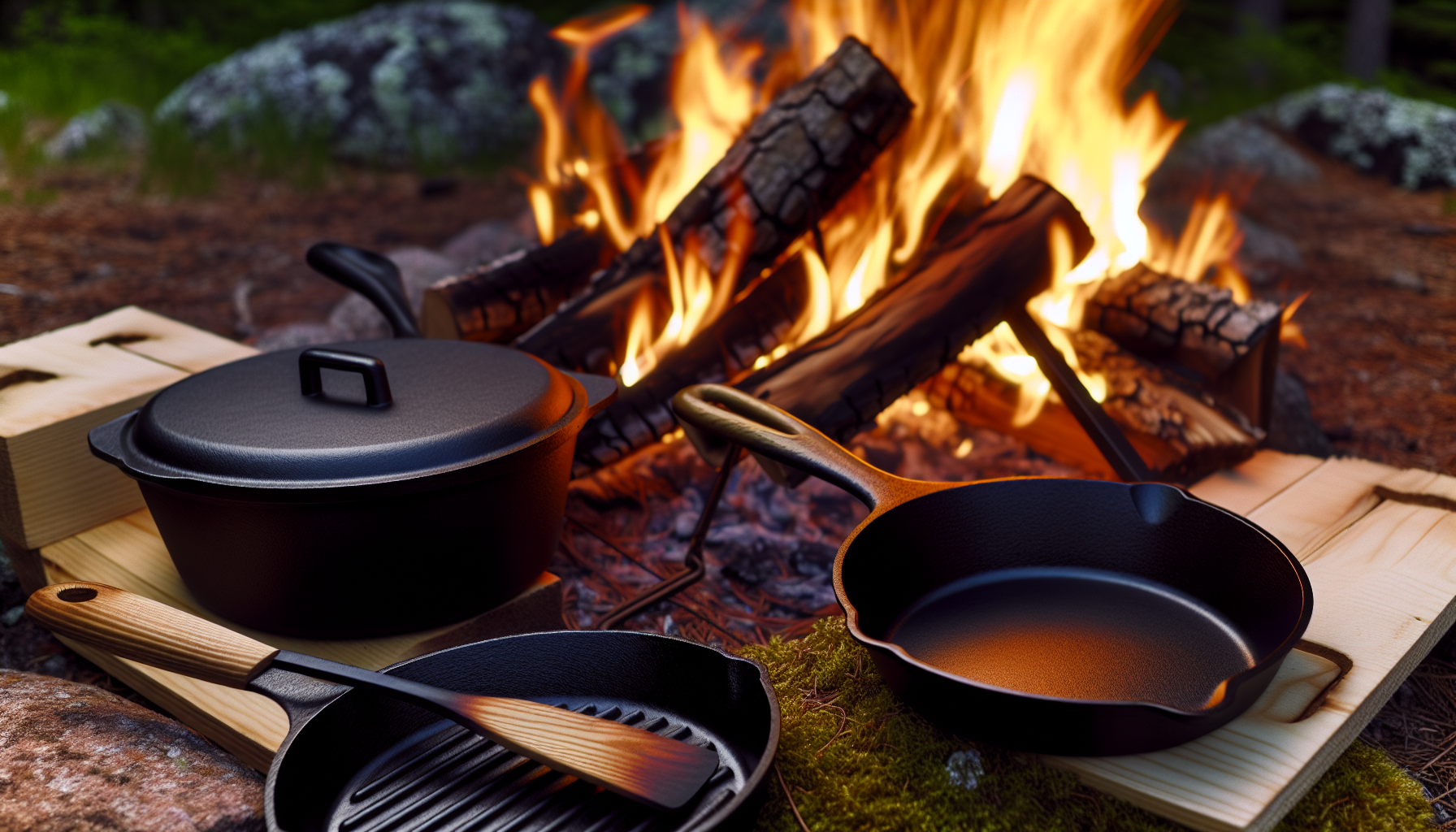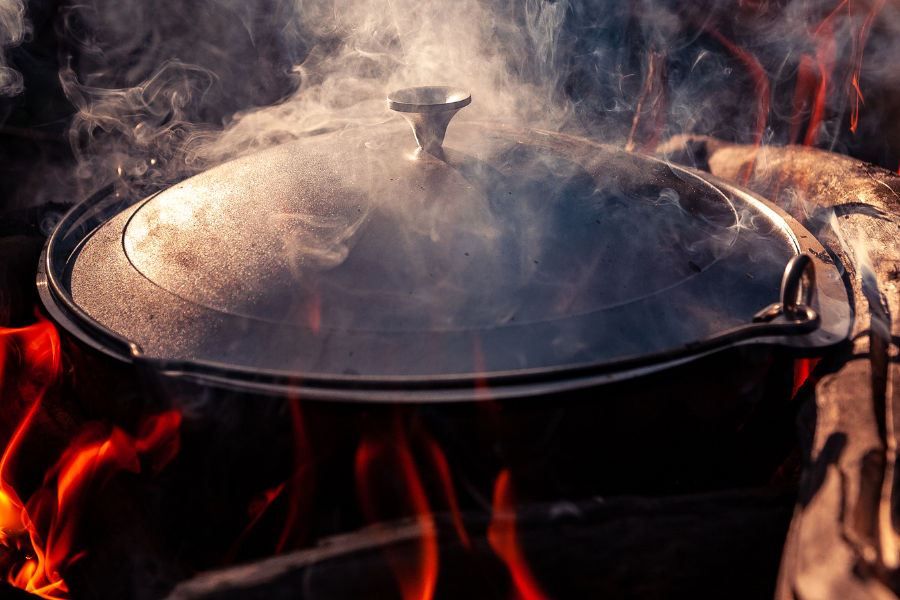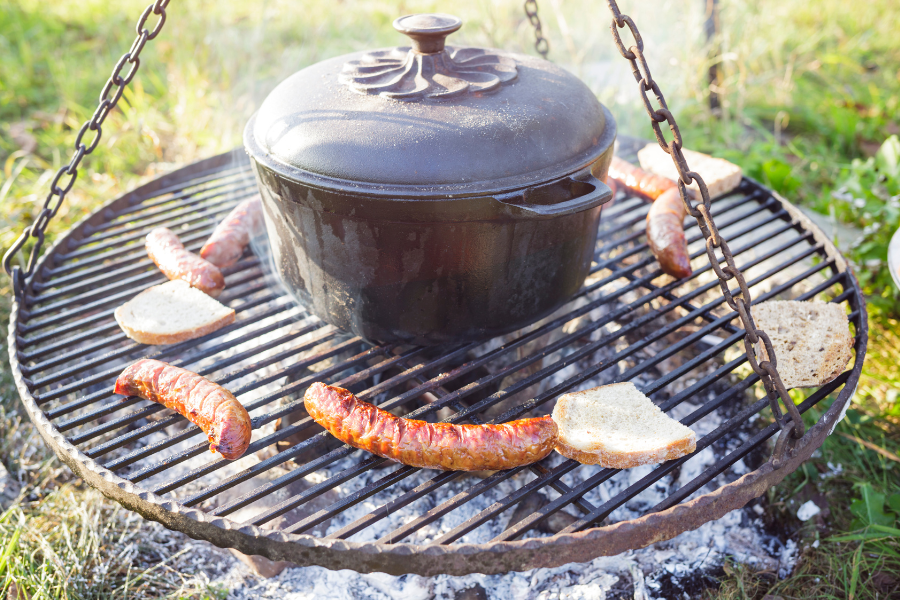Camp Cooking with Cast Iron: A Guide to Delicious Outdoor Meals
Key Takeaways:
Cast iron cookware is versatile and ideal for camp cooking, providing even heat and enhancing flavor.
Proper care and maintenance of cast iron, including seasoning and cleaning, ensure a non-stick surface and longevity.
A variety of meals, from breakfast to dinner, can be easily prepared with cast iron over a campfire or camp stove.
Cast iron cookware has been a staple in outdoor cooking for centuries, and for good reason.
You likely have a pan at home and know that it’s sturdy and can handle a lot of heat.
Its durability, versatility, and ability to retain and evenly distribute heat make it the perfect companion for your next camping trip.
I use my old cast iron pans for camping that were handed down to me by my grandmother. Now that’s something built for longevity that you don’t get very often!
Whether you’re a seasoned camper or a novice to the great outdoors, this guide will walk you through the ins and outs of camp cooking with cast iron.

The Essentials of Cast Iron Cookware
When it comes to camp cooking with cast iron, the most common pieces are the cast iron skillet and the cast iron dutch oven.
These two items alone can cover a wide range of camping meals, from frying bacon for breakfast to baking a delicious dutch baby for dessert.
The best cast iron cookware comes pre-seasoned, providing a non-stick surface that improves with each use.
Remember to pack a lid lifter, hot pad, and parchment paper to handle and protect your cookware.
Preparing Your Cast Iron for the Campsite
Before heading out on your next trip, it’s crucial to ensure your cast iron is ready for the task.
Seasoning your cast iron pan or dutch oven creates a non-stick surface and prevents rust.
Simply coat it with a thin layer of oil and bake it in the oven.
At the campsite, a paper towel can be used to apply a thin layer of oil after each cleaning to maintain the seasoning.
This simple step will make your camp cooking experience much more enjoyable.
Mastering Heat Control with Charcoal Briquettes
One of the secrets to successful dutch oven cooking is mastering heat control.
Charcoal briquettes are a reliable heat source that can be easily managed.
For baking, place more coals on the lid than under the pot to mimic an oven’s heat distribution.
When simmering a stew or chili, maintain a low heat by using fewer coals and monitoring the temperature to prevent burning.

Cooking Over an Open Fire
Campfire cooking with a cast iron skillet or pot adds a smoky flavor that can’t be replicated in a home kitchen.
Use a cooking grate to stabilize your cookware over the flames. For direct heat, place the skillet or dutch oven on hot coals, and for indirect heat, position it next to the fire.
Always keep an eye on your food to prevent it from burning, as the heat from an open fire can be less predictable than charcoal.
Seasonal Delights: Fresh Recipes for Every Camp Outing
When it comes to cast iron camping, the seasons can inspire a variety of fresh recipes that make the most of local produce.
Imagine a summer campfire where you’re sizzling sweet corn and bell peppers in your pre-seasoned cast iron pot, infusing them with a smoky flavor that only outdoor cooking can provide.
This cooking method not only enhances the taste but also maintains the nutrients of your fresh ingredients, making every meal a healthy feast.
In the cooler months, your cast iron becomes the perfect vessel for hearty stews and chilis.
A fall camping trip might see you simmering a pumpkin and black bean chili that warms the soul and fills the air with autumnal spices.
Camp cooking with cast iron can also take you straight into winter camping. They are sturdy enough to be used directly on a wood stove inside your tent to make delicious hot meals.
The non-stick surface of a well-maintained cast iron ensures that even the most tomato-rich chili won’t leave a hard-to-clean mess, letting you enjoy the cool evening without dreading the cleanup.
Cast Iron Skillet Techniques for the Perfect Sear
When it comes to achieving that perfect sear on your favorite cuts of meat, a cast iron skillet is your best friend at the campsite.
The non stick surface of a well-seasoned cast iron pan is ideal for cooking steaks, chicken breasts, or even fish fillets to perfection.
The key is to let the skillet get hot enough so that the meat sizzles as soon as it touches the pan, sealing in those delicious juices and creating a delectable crust.
To master this technique, start by patting your meat dry with paper towels to remove any excess moisture.
Then, coat it lightly with oil and your choice of seasonings.
Place your skillet over the campfire or stove and let it heat up for a few minutes. Once it’s hot, lay your meat in the skillet and resist the temptation to move it around. Let it cook undisturbed for a few minutes before flipping it over to sear the other side.
This method will give you a restaurant-quality result right at your campsite.

The Art of Baking with Cast Iron at the Campsite
Baking in the great outdoors can be a delightful experience, especially when you bring a cast iron Dutch oven into the mix.
The even heat distribution of cast iron makes it perfect for baking everything from fresh bread to decadent cobblers.
To get started, you’ll need to master the technique of creating an oven-like environment, which involves strategically placing hot charcoal briquettes both under and on top of the Dutch oven. This method ensures a consistent temperature, mimicking the conditions of an indoor oven.
When it comes to campsite baking, the possibilities are endless.
Imagine waking up to the aroma of freshly baked cinnamon rolls or enjoying the rustic charm of a skillet cookie under the stars.
The key to successful cast iron baking is to preheat your cookware and to rotate it periodically to avoid hot spots.
Don’t forget to check on your baked goods regularly, as cooking times may vary with the fluctuating conditions of an open fire.
With a little practice, you’ll be able to produce mouthwatering baked treats that will be the highlight of any camping trip.

Innovative Uses of Cast Iron for Campsite Grilling
Grilling at the campsite doesn’t have to be limited to the traditional barbecue setup.
Camp cooking with a cast iron grill pan or griddle, expands your outdoor culinary repertoire.
The ridges on a cast iron grill pan are perfect for giving your meats and vegetables those coveted grill marks. While the flat surface of a griddle is ideal for cooking up pancakes, eggs, or even toasting buns for your burgers.
One of the innovative ways to utilize cast iron for grilling is to use it directly on the campfire coals.
This method allows for intense direct heat, perfect for searing steaks or charring veggies to perfection.
Remember to preheat your cast iron to ensure it’s hot enough for that instant sizzle. Don’t shy away from experimenting with different types of wood or charcoal to infuse your food with unique smoky flavors.
Whether you’re grilling up a storm or flipping flapjacks, cast iron cookware is your versatile companion for creating unforgettable meals in the wild.
Crafting the Ultimate Campfire Breakfast
Breakfast is the most important meal of the day, especially when you’re fueling up for a day of outdoor adventures.
Your cast iron cookware can turn a simple morning meal into a feast to remember. Pre-seasoned cast iron skillets are particularly handy for creating a non stick surface. This makes flipping pancakes or frying eggs a breeze.
Imagine starting your day with a stack of fluffy pancakes topped with fresh berries and a drizzle of maple syrup, all cooked to golden perfection on your trusty skillet.
For a hearty campfire breakfast, consider a one-pan recipe that includes eggs, diced potatoes, and your choice of breakfast meats.
Begin by cooking the meats until they’re crispy, then add the potatoes and any vegetables you like. Once those are tender, create small wells in the mixture and crack an egg into each one.
Cover the skillet with a lid or aluminum foil and let the eggs cook to your desired doneness.
Serve straight from the skillet for a family-style meal that will energize your group for the day ahead.
Cast Iron Beyond the Main Course: Side Dishes and Desserts
Who says cast iron is only for the main course?
Let’s talk about side dishes that can steal the show.
A crispy, golden-brown cornbread baked in a cast iron skillet is the perfect companion to your campfire chili.
The even heat distribution of the skillet gives it that desirable crust that’s soft on the inside, making it a side dish that might just eclipse the main attraction. And because of the non-stick surface, serving and cleaning become a breeze, leaving more time to enjoy the starry night.
But wait, there’s more!
Have you ever thought of making a pizza in the wilderness?
With a cast iron skillet, you can!
Just imagine pulling a hot, bubbly pizza out of the campfire, with a perfectly charred crust that’s been cooked over an open flame.
This unexpected twist on camp cooking will surely impress your fellow campers.
And the best part?
The pre-seasoned surface means you can slide that pizza right onto your plate with ease, making you the coolest chef under the open sky.
Utilizing a Camp Stove for Convenience
For those who find cooking over an open fire too much work or who are camping in areas with fire restrictions, a camping stove is an excellent alternative.
A cast iron pan or pot can be used on most camping stoves just as you would on a home stove.
The controlled heat source makes it easier to cook dishes like eggs or pancakes without the worry of uneven cooking or flare-ups.

Delicious Recipes to Try
The versatility of cast iron cookware means the possibilities for your camping meal plan are endless.
Start your day with a hearty breakfast of bacon and eggs in a cast iron skillet.
For lunch, grill up some chicken or pork on a cast iron grill pan.
Come dinner time, a cast iron dutch oven is perfect for a one-pot meal like chili or a campfire stew.
And don’t forget dessert – a dutch oven is ideal for baking cinnamon rolls or a warm, gooey chocolate cake.
Cleaning and Maintenance at the Campsite
After enjoying a delicious meal, it’s important to clean your cast iron properly to maintain its non-stick surface and prevent rust.
Avoid using soap, as it can strip the seasoning. Instead of soap, use hot water and a non-metal brush to remove any food residue. Dry the cookware thoroughly and apply a thin layer of oil with a paper towel before storing.
With proper care, your cast iron will last for many camping trips to come.
Packing Tips for Your Cast Iron Gear
When you to go pack your camping gear, it’s important to protect your cast iron cookware.
Wrap each piece in a towel or use parchment paper between them to prevent scratching.
If you’re bringing a cast iron dutch oven, consider a lid stand to keep the lid off the ground. Also consider a charcoal chimney for easy lighting of charcoal briquettes.
With these tips, your cast iron will arrive at the campsite ready for cooking.
Final Thoughts
Camp cooking with cast iron is an enjoyable and flavorful way to enhance your outdoor experience.
By choosing the right cookware, mastering heat control, and trying out various recipes, you can create delicious meals that will be the highlight of your camping trip.
Remember to properly maintain your cast iron by seasoning and cleaning it correctly, and it will serve you well for many adventures to come.
FAQ Section
Q: Can I use my cast iron cookware on a camp stove?
A: Yes, cast iron pans and dutch ovens can be used on most camping stoves. The even heat distribution of cast iron makes it ideal for cooking on a camp stove.
Q: How do I clean my cast iron cookware while camping?
A: Clean your cast iron with hot water and a non-metal brush. Avoid using soap, and make sure to dry it thoroughly before applying a thin layer of oil to maintain the seasoning.
Q: What are some easy cast iron recipes for camping?
A: Some super easy recipes include skillet bacon and eggs for breakfast, grilled cheese sandwiches for lunch, and one-pot chili or stew for dinner. For dessert, try baking cinnamon rolls or a dutch baby in your dutch oven.





Comments are closed.